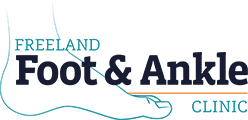Bunions are a very common foot deformity, and they can cause a lot of distress—especially if you ignore them for too long.
At first, all you may notice is a small bulge at the base of your big toe. In the earliest stages, bunions aren’t large and may not even be painful or keep you from any of your favorite activities. The distraction may be purely cosmetic.
But sadly, bunions generally don’t stay that way. As they grow in size, and your toe drifts further out of alignment, you may find it harder and harder to wear normal shoes or perform daily activities without noticeable physical discomfort.
Fortunately, there are many simple, conservative strategies you can follow to help minimize your bunion pain and potentially even slow its progression—and they are especially effective if you begin performing them as soon as you notice your bunion beginning to form.
Here are a few of our top tips for relieving bunion pain.
If the Shoe Hurts, Don’t Wear It!
There is some disagreement in the medical community over whether poor footwear actually causes bunions. However, it is clear that poor shoes can make the symptoms you experience significantly worse!
Avoid high heels, as well as shoes that fit tightly around the balls of the feet or the toes, or lack good cushioning and arch support. Instead, choose roomy and comfortable shoes that give your toes plenty of space to wiggle.

Try Some Bunion Pads
Bunions can be painful all on their own, especially if the toe joint becomes arthritic. However, secondary complications due to irritation and friction from the bunion rubbing against the inside of the shoe—including corns, calluses, and blisters—can also be a major concern.
A good way to protect your skin is by using a moleskin or gel-filled bunion pad. Just make sure the pads are non-medicated. You can find these in most drugstores, but if you aren’t sure what to buy, feel free to give us a call—we will likely have some in supply at our office.

Use Splints or Toe Spacers
For this tip, we do recommend you come to our office first, so we can make sure you get an appropriate device and provide some additional usage guidelines.
Splints and toe spacers are normally worn at night, and are meant to help hold the big toe in proper alignment. This can ease your discomfort, help you sleep better, and possibly even reduce the bunion’s rate of progression.
Find the Right Pair of Orthotics
Almost all bunions can be traced, at least in part, to a fundamental instability in the structure or motion of your feet and ankles.
Wearing an appropriate set of orthotics or arch supports not only helps redistribute weight and pressure away from a painful bunion, but may be able to correct the faulty biomechanics that are causing the bunion in the first place.
But you don’t want to just pick a set of arch supports off the rack at the pharmacy. Dr. Dailey will help you find a set that is appropriate for your feet—either a prefabricated model or, if necessary, a set of custom orthotics.
Stretching, Exercise, and Massage
To be clear, there is no way to make a bunion disappear, or even become smaller, using physical therapy alone.
However, performing certain toe and foot stretches and exercises can still be hugely beneficial! They can help keep your joint as flexible and supported by strong connecting muscles and tissues as possible, which not only means less pain, but potentially slower progression of the deformity. Even a little self-massage at the end of the day can significantly improve your comfort level.
Enjoy a Nice Foot Soak
A simple foot soak can actually work pretty well at soothing pain and reducing inflammation when bunion symptoms spike. Plus it can be very relaxing, and you can do it while reading or watching TV.
We recommend using cool or at most lukewarm water, with a little bit of Epsom salt (or whatever bath salts you prefer). Soak for about 10 to 15 minutes at a time—that should be plenty to help ease the pain, and soaking too long can damage your skin.
Use Pain Relieving Medications (as Directed)
Certainly, the last thing we would want is for you to rely on taking painkillers on a daily basis. If that is your situation, please give us a call so we can help you take a different approach.
That said, if pain symptoms do temporarily spike, it’s good to have over-the-counter anti-inflammatories or topical analgesics on hand to provide some quick-acting and temporary relief. If necessary, we can provide a cortisone injection for tougher pain.
Maintain a Healthy Body Weight
You might not think of this as a bunion relief strategy, but it actually makes some sense when you think about it. The heavier you are, the more weight, pressure, and impact forces are exerted across your feet when you walk. If you are overweight, making healthy lifestyle changes and losing a few pounds can actually ease your bunion symptoms more than you might expect.
Don’t Be Afraid of Surgery
At Freeland Foot & Ankle Clinic, we will never rush anyone into bunion surgery. We consider it strictly a last resort, and we’ll do everything we can to help you avoid it, or at least delay the need for it as long as possible.
However, if you’re dealing with daily pain, unable to live the life you want to live, and conservative treatments are just not cutting it anymore, surgery may be your best choice. And while that does mean you’ll likely spend a few weeks off your feet and a few months with some activity restrictions, in the grand scheme of things that’s a pretty small price to pay when the result is healthy feet and long-term relief.
LEARN MORE: When Should You Consider Bunion Surgery?
We are happy to guide you through whatever steps you need to take to ensure the best possible outcome for your health and happiness with the minimum possible disruption to your lifestyle. Do not wait for bunions to become severe before contacting our office. Call us at (989) 695-6788, or request an appointment online.

